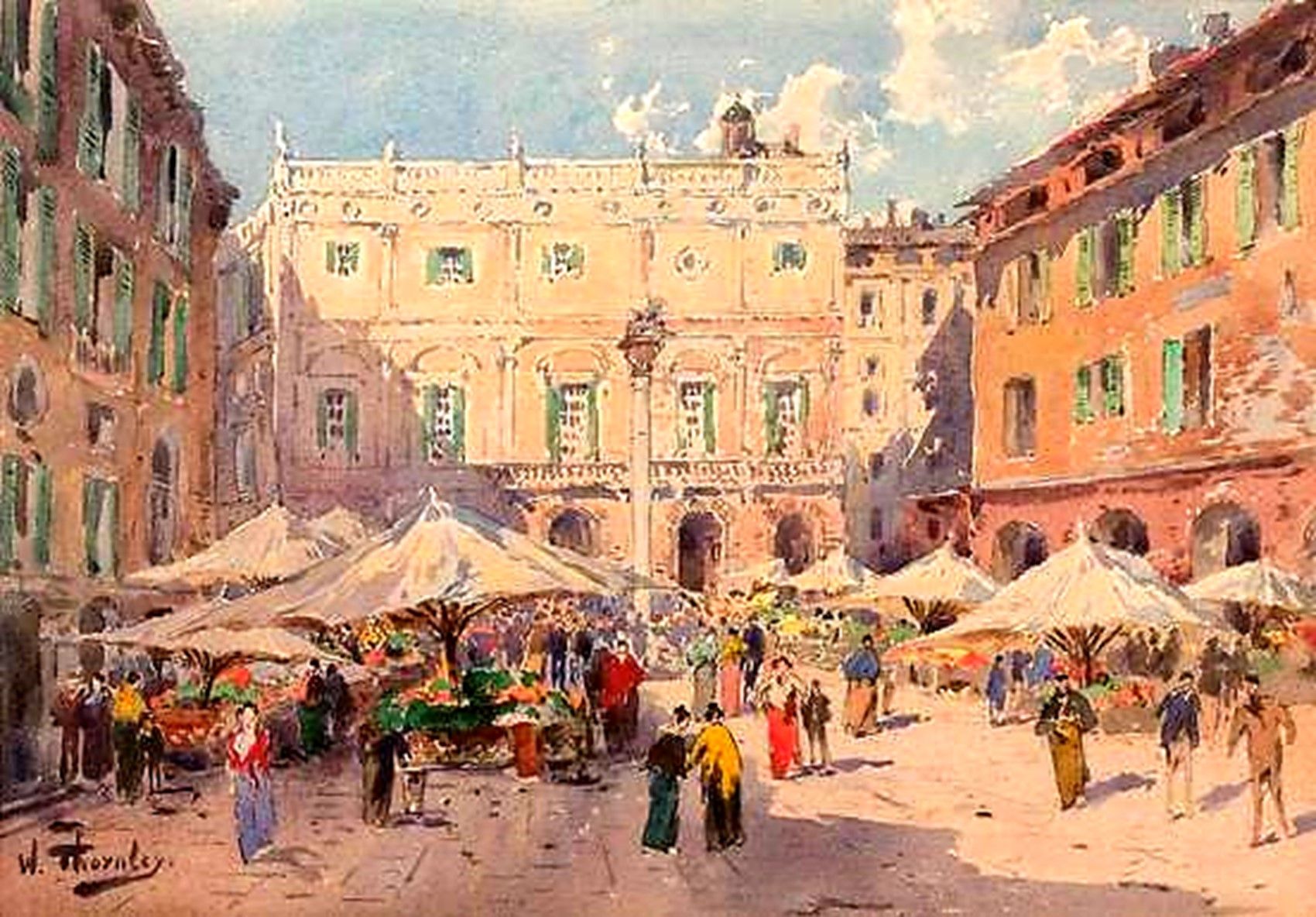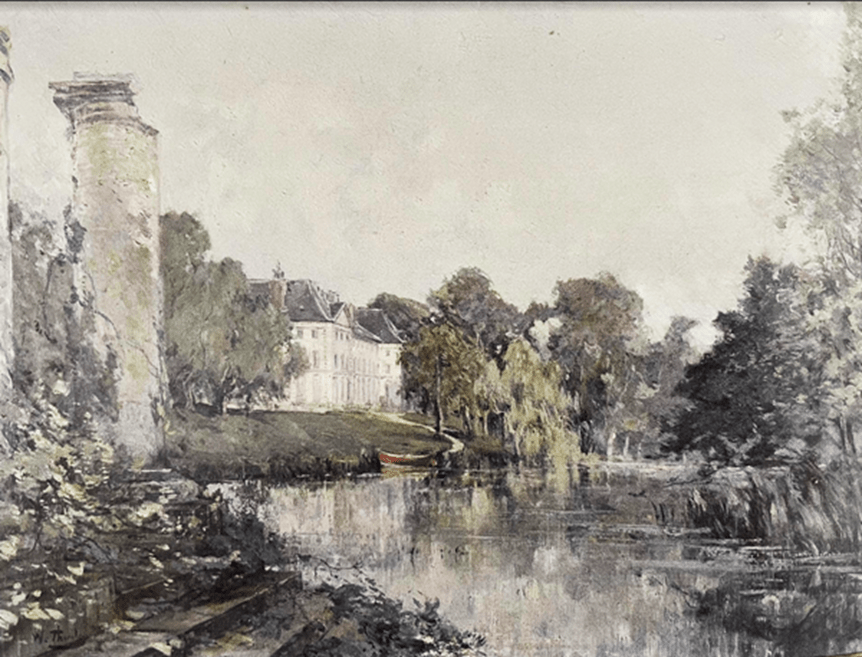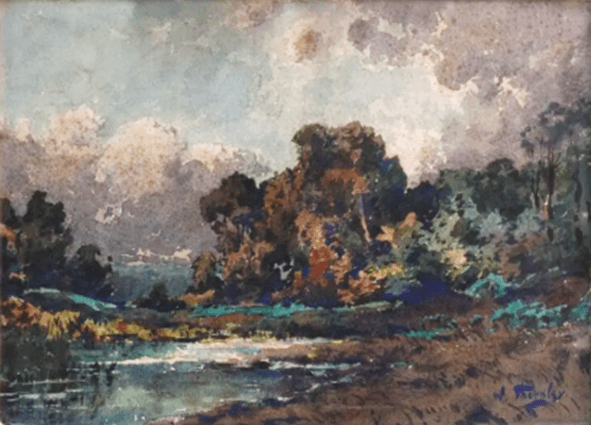Place animée de Vérone. (Piazza delle Erbe). Aquarelle (24,8 x 34,8cm) – Collection privée (entre 1918 et 1925)
Lors de sa dernière vente, cette aquarelle portait le titre de « place vénitienne animée ». En réalité, après quelques recherches complémentaires, il s’avère qu’il ne s’agit pas d’une place de Venise, mais d’une place de Vérone. Quoiqu’il en soit, cette magnifique aquarelle, réalisée après 1900, a beaucoup de charme. Elle restitue l’ambiance très animée d’un jour de marché sur une très jolie place de Vérone.
Véritable page d’histoire à ciel ouvert, cette Place a été construite au premier siècle de notre ère sur les vestiges d’un ancien forum romain qui comprenait à l’époque un Capitole, des temples et des thermes. On aperçoit au fond le « Palazzo del Comune » du XIIIe siècle , qui fut pendant des siècles le centre du pouvoir de la ville. On remarque également, au centre de la place, la Colonna di San Marco , réalisée en marbre blanc en 1523 pour souligner le retour de la domination vénitienne (cette colonne est surmontée du lion symbole de Venise). William Thornley a séjourné à de nombreuses reprises en Italie. En 1880 il s’y rendit à l’occasion d’un grand cycle de voyages qui débuta dans le midi de la France pour se poursuivre sur la Riviera française puis Italienne et jusqu’à Malte. Il s’y rendit également en Italie en 1907, 1918, 1920, 1922 et 1924. Le format de la signature et le style de l’œuvre plaident pour une datation se situant probablement entre 1918 et 1925.
William Thornley a utilisé, pour réaliser cette aquarelle, une grande variété de couleurs vives et contrastées, des tons très chauds, bien loin des couleurs ternes qui caractérisèrent ses premières compositions. La façade aux tons ocres clairs située au fond de la place, et dont le haut se profile dans un ciel bleu azuréen, réfléchit la forte luminosité du soleil. On en perçoit également les effets au travers du jeu visuel créé par les savants effets d’ombre et de lumière.
La partie plus sombre, d’apparence violacée, qui s’inscrit dans la prolongation du toit de l’immeuble de gauche, contribue à l’effet de perspective. Ses contours forment une diagonale qui partitionne, en quelque sorte, la scène en deux parties : l’une, protégée de la lumière, et l’autre, exposée au soleil. L’ensemble, tel un « Ying » et un « Yang » chromatiques, se complète harmonieusement et renforce positivement le jeu subtil des contrastes. Les étals sont soigneusement protégés par de grands parasols. Dans cette composition soignée, une multitude de personnages distincts, hommes femmes ou enfants, vaquent à leurs occupations respectives, contribuant ainsi à y créer une dynamique visuelle particulière. On imagine sans peine le joyeux brouhaha qui se dégage de cette place de marché animé !

Lively square in Verona. (Piazza delle Erbe). Watercolor (24.8 x 34.8cm) – Private collection (between 1920 and 1925)
When it was last sold, this watercolor carried the title “lively Venetian square.” In reality, after some additional research, it turns out that it is not a square in Venice, but a square in Verona. Regardless, this magnificent watercolor, produced after 1900, has a lot of charm. It recreates the very lively atmosphere of a market day on a very pretty square in Verona.
A true page of open-air history, this Square was built in the first century AD on the remains of an ancient Roman forum which at the time included a Capitol, temples and thermal baths. In the background we can see the 13th century « Palazzo del Comune », which for centuries was the center of power in the city. We also note, in the center of the square, the Colonna di San Marco, made of white marble in 1523 to mark the return of Venetian domination (this column is topped with the lion, symbol of Venice). William Thornley visited Italy on numerous occasions. In 1880 he went there on the occasion of a major cycle of travels which began in the south of France and continued on the French and then Italian Riviera and as far as Malta. He also went to Italy in 1907, 1918, 1920, 1922 and 1924. The format of the signature and the style of the work suggest a dating probably between 1918 and 1925.
William Thornley used, to create this watercolor, a wide variety of bright and contrasting colors, very warm tones, far from the dull colors which characterized his first compositions. The facade in light ocher tones located at the back of the square, the top of which is silhouetted against a Riviera blue sky, reflects the strong luminosity of the sun. We also perceive the effects through the visual play created by the clever effects of light and shadow.
The darker part, with a purplish appearance, which is part of the extension of the roof of the building on the left, contributes to the effect of perspective. Its contours form a diagonal which, as it were, partitions the scene into two parts: one, protected from light, and the other, exposed to the sun. The whole, like a chromatic “Ying” and “Yang”, complements each other harmoniously and positively reinforces the subtle play of contrasts. The stalls are carefully protected by large umbrellas. In this careful composition, a multitude of distinct characters, men, women or children, go about their respective occupations, thus helping to create a particular visual dynamic. It’s easy to imagine the joyful hubbub that emanates from this lively market place!



